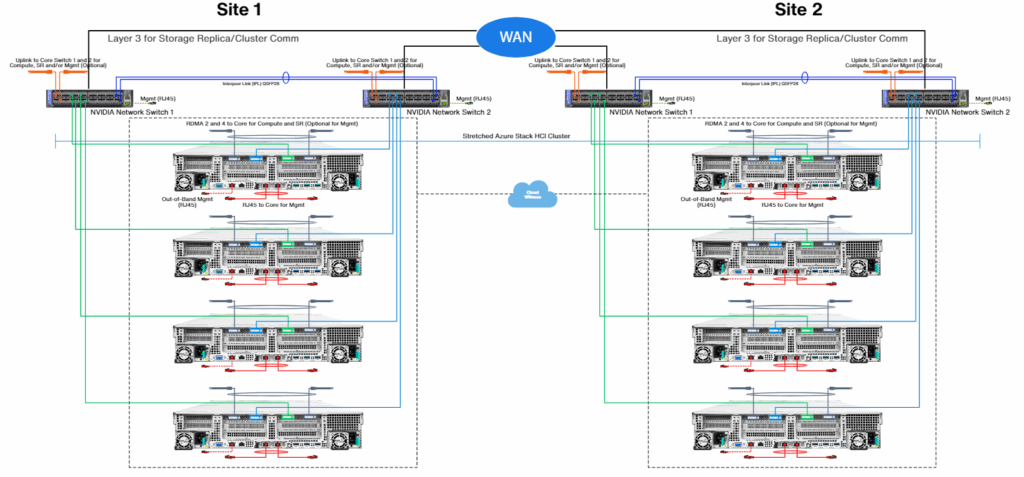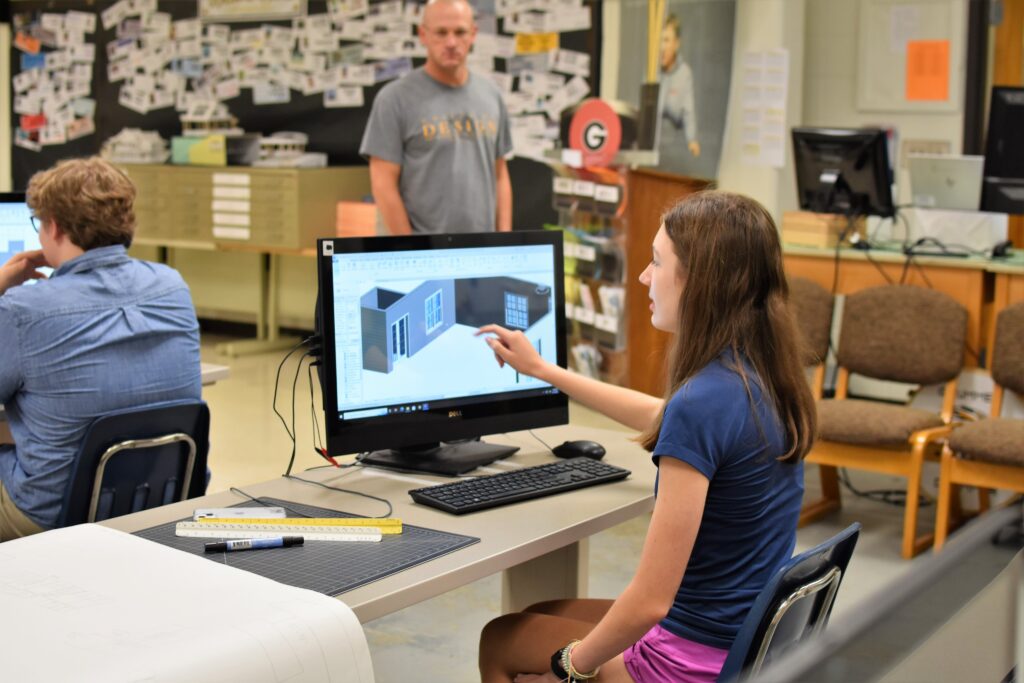
Solutions
- DataON AZS-6224 Integrated System for Azure Stack HCI with 3rd Gen Intel® Xeon® Scalable processors
- Azure Stack HCI
- Hyper-V
- Azure Virtual Desktop (AVD)
- Azure Kubernetes Service (AKS)
- Azure Arc
- Windows Admin Center
- DataON MUST & MUST Pro
- Solidigm P5510 all-NVMe flash storage
- NVIDIA ConnectX-6 100GbE RDMA adapters
- NVIDIA Spectrum 100GbE switches running NVIDIA Cumulus Linux OS
Industry
- Education
Org Size
- 5001 to 10000 employees
Country
- United States
Download
The Challenge
- Eliminate traditional SAN infrastructure with scalable and easy-to-manage hybrid cloud platform
- Eliminate IT bottlenecks, improve SQL and K-12 application performance with 24/7 uptimes
- Simplify on-premises and cloud management with Azure Arc and Windows Admin Center
- Streamline app development with containers
The Solution
- Microsoft HCI hybrid cloud platform: DataON AZS-6224 Integrated System for Azure Stack HCI
- All-flash NVMe solution for SQL and database workloads
- DataON MUST and MUST Pro management software
- Azure Arc hybrid and multi-cloud management tool
- Azure Virtual Desktop (AVD) to enable students to use CAD and Microsoft Office with Chromebooks
The Result
- Successfully transitioned from 3-tiered iSCSI SAN to Azure Stack HCI solution
- Deployed active-active stretched cluster running Hyper-V
- Increased QoS for SQL and enterprise application workloads by 10x
- Simplified, centralized deployment and management of data services using Windows Admin Center, Azure Arc, Azure Portal, and DataON MUST Pro
- Modern containerized applications can now be tested and validated using AKS on Azure Stack HCI
- Evaluating Azure hybrid services such as AVD, AKS and Azure Arc
Cherokee County School District Goes On A Hybrid Cloud Journey with Microsoft & DataON
Cherokee County School District (CCSD) is a high-performing K-12 public school system in the metro Atlanta area. It serves more than 42,000 students with over 5,200 employees in 41 schools and centers. The CCSD Department of Technology and Information Services conducts software and system development, web programming and network engineering and provides IT support for teachers, administration, and students. The department also works to identify and implement contemporary solutions for modernizing teaching and learning through classroom technology integration.

Making the Microsoft Choice
Matt Roper, Supervisor of Network & Security Services, Technology and Information Services, CCSD, sought to refresh his heavily virtualized, traditional three-tier storage area network (SAN) and eliminate costly VMware fees by transitioning to Microsoft Hyper-V. During his search, Roper found SAN solutions to lack scalability and were cost-prohibitive, limiting him to older, slower technology and a traditional hard disk drive-only (HDD) solution. As a technology-driven school district, Roper needed an infrastructure that could deliver high performance and continue to grow as classrooms became more integrated with 21st century digital technology.
CCSD started its journey to Microsoft hybrid cloud when Roper attended Microsoft Ignite 2016 and first learned about Microsoft Storage Spaces Direct. A new highly resilient, highly scalable hyper-converged infrastructure (HCI) solution that debuted in Windows Server 2016, Storage Spaces Direct combines storage, compute, and networking resources into a cluster of server nodes. Even though software-defined storage was still on the bleeding edge at the time, he found the Microsoft HCI solution an alluring option.
It was at Ignite that Roper met DataON, a hybrid cloud computing company that had been dedicated to exclusively providing Microsoft solutions since the first iteration of Storage Spaces in Windows Server 2012 R2. Roper saw their dedication and expertise in the emerging technology and commitment to providing world-class customer support. He found with a Microsoft HCI solution, he could get the latest technologies, including hybrid-NVMe flash storage for better performance, while still meeting his budget. This would have been impossible with a SAN.
Roper chose an eight-node DataON S2D-5212 hybrid storage solution featuring Intel® Xeon® Scalable processors, Mellanox (now NVIDIA) ConnectX-4 40GbE network adapters and Spectrum 40GbE switches, and Intel NVMe flash and Western Digital hard disk drives. With the new solution, Roper was able to consolidate his infrastructure, simplify management, eliminate VMware costs, and improve virtual machine (VM), SQL and general application performance by 10x. And whenever he needed to add storage in the future, he could simply scale up and add drives, and he could scale out by adding more nodes.
Time to scale out and expand to hybrid cloud
After Roper’s successful Windows Server 2016 Storage Spaces Direct deployment, CCSD’s data center requirements continued to grow. He was looking to again improve overall performance, increasing SQL and K-12 application performance, and add another cluster that he could stretch across two data centers to improve resiliency and disaster recovery. Roper also sought to extend to hybrid cloud and implement cloud services for a more flexible, robust infrastructure.
In addition, CCSD began offering more cutting-edge STEM classes, including an architectural engineering program that teaches students how to use computer aided design (CAD) software to design building plans. Roper was tasked to evaluate a virtual desktop infrastructure (VDI) solution that could be used with Google Chromebooks, enabling students to work in class and at home, while ensuring data governance.
The Evolution of Microsoft HCI
While CCSD’s data center needs continued to grow, Microsoft HCI also continued to grow and evolve from its beginnings with Windows Server. Now formally named Azure Stack HCI, it’s now a complete operating system that’s separate from Windows Server and combines on-premises infrastructure with Azure cloud services. It’s delivered as an Azure Service and billed as an Azure subscription. Azure hybrid services enhance the cluster with features such as Azure Backup, Azure Monitor, Azure Kubernetes Service (AKS), Managed SQL Instance, Azure Virtual Desktop (AVD), and more. And now it integrates your Azure Stack HCI clusters with Azure Arc to monitor your Azure Stack HCI clusters, simplifying governance and management by delivering a consistent management plane from Azure.
DataON’s Microsoft HCI solution has also evolved, with DataON Integrated Systems for Azure Stack HCI. They are complete, validated, turnkey solutions, with premier features and services, like 24/7 world-class technical support from both DataON and Microsoft. They include sixteen hours of customer deployment services, including pre-deployment, readiness, deployment, and training. Every Integrated System also includes pre-deployment baseline testing, benchmarking, and stress testing and shipped with a pre-installed Azure Stack HCI OS and the latest verified drivers and firmware. Exclusive to DataON Integrated Systems is DataON MUST Pro, an extension that integrates with Microsoft’s cluster aware update (CAU) functionality. It ensures that your servers have the same OS version, firmware, BIOS, and BMC, and checks the drives and firmware for network cards, host bus adapters, and SSD and HDD drives. With a single click, MUST Pro can keep your system updated and secure against the latest server exploits.
DataON has more Integrated Systems and validated nodes in the Azure Stack HCI Catalog than any other vendor (as of 11/23/22). DataON also offers validated platforms for Azure Arc-enabled Kubernetes for data services, which includes Azure Arc-enabled SQL Managed Instance that is deployed on Kubernetes as a containerized application.
Improved performance and built for hybrid cloud disaster recovery and on-premises VDI
The DataON team designed an 8-node hybrid cloud solution for CCSD, with the DataON AZS-6224 Integrated System for Azure Stack HCI. The AZS-6224 features 3rd Gen Intel® Xeon® Scalable processors with support for Microsoft Secured core, and all-flash Solidigm P5510 NVMe SSDs. It also included a complete NVIDIA end-to-end networking solution, featuring NVIDIA ConnectX-6 100GbE network adapters and NVIDIA Spectrum 100GbE switches. Spectrum switches come pre-installed and configured with Cumulus Linux 5.1 or later and meet the physical networking requirements for Azure Stack HCI, including Priority Flow Control (PFC), Enhanced Transmission Selection (ETS), and Custom TLVs in LLDP transmission.
With their new DataON Integrated System for Azure Stack HCI, CCSD’s overall data center performance increased from 2.5M to 4M IOPS, significantly increasing QoS for SQL and enterprise applications by 10x.
Taking advantage of Microsoft Secured-core server with new encryption and cryptography features in 3rd Gen Intel® Xeon® Scalable processors, CCSD’s infrastructure was now safer from malware and ransomware attacks at the core, BIOS, firmware and memory level, and dynamic root of trust measurement (DRTM).
Roper installed four nodes in his primary data center and four in his secondary data center. Using an intuitive, streamlined wizard in Windows Admin Center, Roper was able to quickly create an active-active stretched cluster across the two data centers, automatically setup storage replication, build a data volume, replicate volume between sites, and choose replication direction and replication mode.
CCSD’s active-active cluster enabled the two data center sites to run the same applications simultaneously, achieving load balancing and ensuring that none of the sites are overloaded. Using Storage Replica, Roper can simultaneously replicate volumes across the two sites for disaster recovery, keeping all servers in sync. If one of the CCSD sites fail, the automatic failover feature repurposes the replicated drives as data drives at the other site, utilizing them for Windows and VMs, and automatically starts them, ensuring continuous uptime without data loss.

Roper was also able to successfully set up Azure Virtual Desktop (AVD) on his Azure Stack HCI deployment. This has enabled him to quickly deploy, manage, and scale fully optimized Windows 11 desktops with centralized data governance so CCSD architecture engineering students throughout the county can run CAD on their Google Chromebooks.
App development with containers is now simplified for CCSD, as they can now test and validate modern containerized applications using Azure Kubernetes Service (AKS) on Azure Stack HCI. CCSD is now able to utilize its hybrid capabilities to deploy modern applications anywhere – cloud, on-premises, and edge.
With DataON Integrated Systems for Azure Stack HCI, keeping the data center up to date has never been easier. With just a few clicks, Roper can use Microsoft Windows Admin Center to update the Azure Stack HCI OS and DataON MUST Pro to update every DataON node, component, or switch in his infrastructure with the latest quarterly validated Microsoft updates, ensuring there are no compatibility issues and shaving hours off the update process.
“Microsoft has a winner,” said Roper. “Everything is incredibly faster, feels 10 times faster. Tasks that used to take minutes to complete, now only takes seconds. Hyper-V was easy to learn and use, and it took us a tenth of the time to set it up than with VMware. We’re really excited about the new Azure services and hybrid capabilities that can now be used with Azure Stack HCI.”

About DataON
DataON is a hybrid cloud computing company focused on delivering Microsoft Azure Stack HCI, on-premises compute and storage systems, intelligent edge AI/ML appliances and Microsoft Azure hybrid cloud services. Our company is helping enterprises and customers who have made the “Microsoft choice” to modernize their IT with Microsoft applications, hybrid cloud workloads, Hyper-V virtualization, and data protection.
DataON has deployed over 850 HCI clusters and 150PB of storage. Our enterprise-level solutions, delivered as a complete, turnkey experience, are designed to provide the highest level of performance, manageability, and security offered. DataON is a Microsoft Gold Partner, Microsoft Cloud Service Provider (CSP), and an Intel Platinum Partner.